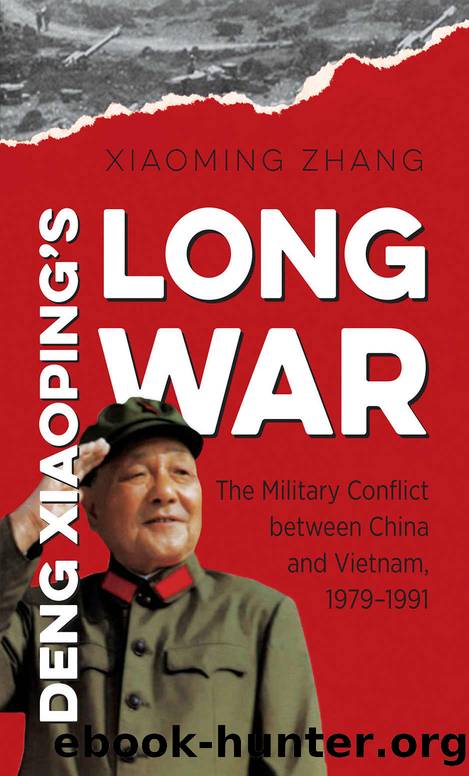Deng Xiaoping's Long War: The Military Conflict between China and Vietnam, 1979-1991 (The New Cold War History) by Xiaoming Zhang

Author:Xiaoming Zhang [Zhang, Xiaoming]
Language: eng
Format: azw3
Publisher: The University of North Carolina Press
Published: 2015-05-05T16:00:00+00:00
Seizing Vietnamese Strongholds on the Border, 1980–1983
In the PLA history, taking military action against the Vietnamese occupied positions along the border during this period is known as “Offensive Operations against the Enemy’s Controlled Points” (badian zuozhan). The first major action, in October 1980, was to recapture the Luojiaping mountain range on the Yunnan-Vietnam border. The mountain range consists of several hills, with its highest peak at an elevation of 2,002 meters on the China side of the boundary near the village of Jinchang. On 25 September, the PLA border unit received a report that Vietnamese troops had occupied the hills of Luojiaping, were fortifying their positions, and were laying mines. More seriously, a few days later, a PLA patrol clashed with Vietnamese troops: 5 Chinese soldiers, including a company commander, were killed or missing in action. Thus provoked, local military authorities decided to retaliate.23
On 15 October, the PLA attacked the Vietnamese positions on the Luojiaping range. In a 3.5-hour fight they killed 42 enemy troops and captured 3.24 On 9 November, the PLA attacked another Vietnamese-defended mountain, Ma’anshan (Hill 1175.4). At its foot was a highway connecting Malipo in the north and the Vietnamese border town of Thanh Thuy in the south. Further southwest, the 1,700-meter peak of Koulinshan Mountain dominated the horizon, signaling its dubious distinction as objective of the next Chinese offensive.25
In light of Beijing’s decision to maintain military pressure on Vietnam, PLA forces in Guangxi and Yunnan selected Fakashan (near the city of Pingxiang) and Kuolinshan for attack. The military action, initially scheduled for New Year’s Day 1981, was ostensibly postponed by mountain floods in the region. Perhaps the real but unspoken reason for the postponement was that these attacks would be the first major operations by the PLA since 1979 and the PLA’s military leadership had no desire to oversee a disappointing PLA performance on the battlefield: they recognized that more planning and training were needed to ensure success. Thus, the military action did not take place until early May.26
Both Fakashan and Koulinshan comprise several peaks, with each occupying an area of less than 10 square kilometers. They were defended by troops from the PAVN 327th and 313th Divisions, respectively. To confront them, the CMC ordered deployment of seven PLA infantry regiments and four artillery regiments to the Guangxi–Lang Son border; in addition, the 42nd Division from the PLA’s 14th Army was deployed to the Yunnan–Ha Tuyen (now Ha Giang) border.27 The PLA deployed these robust forces to counter Vietnamese forces, which had fortified their positions with trenches, firing points, and mines. The main thrust of attack in Guangxi was assigned to the 9th Regiment of the 3rd Border Defense Division; in Yunnan, it was assigned to the 126th Regiment of the 42nd Division.28
The assault began on 5 May 1981 in Guangxi and two days later in Yunnan. Each attack followed a massive preparatory artillery barrage. One PLA company captured Vietnamese positions at three separate heights (two of them on the Vietnam side of the border) on Fakashan in less than an hour, with 26 PAVN soldiers killed and 43 wounded.
Download
This site does not store any files on its server. We only index and link to content provided by other sites. Please contact the content providers to delete copyright contents if any and email us, we'll remove relevant links or contents immediately.
| Africa | Americas |
| Arctic & Antarctica | Asia |
| Australia & Oceania | Europe |
| Middle East | Russia |
| United States | World |
| Ancient Civilizations | Military |
| Historical Study & Educational Resources |
The Sympathizer by Viet Thanh Nguyen(4286)
The Rape of Nanking by Iris Chang(4123)
World without end by Ken Follett(3415)
Ants Among Elephants by Sujatha Gidla(3399)
Blood and Sand by Alex Von Tunzelmann(3118)
Japanese Design by Patricia J. Graham(3094)
City of Djinns: a year in Delhi by William Dalrymple(2500)
The Queen of Nothing by Holly Black(2465)
Foreign Devils on the Silk Road: The Search for the Lost Treasures of Central Asia by Peter Hopkirk(2421)
India's Ancient Past by R.S. Sharma(2404)
Inglorious Empire by Shashi Tharoor(2383)
Tokyo by Rob Goss(2380)
In Order to Live: A North Korean Girl's Journey to Freedom by Yeonmi Park(2330)
India's biggest cover-up by Dhar Anuj(2305)
Tokyo Geek's Guide: Manga, Anime, Gaming, Cosplay, Toys, Idols & More - The Ultimate Guide to Japan's Otaku Culture by Simone Gianni(2303)
The Great Game: On Secret Service in High Asia by Peter Hopkirk(2296)
Goodbye Madame Butterfly(2191)
Batik by Rudolf Smend(2106)
Living Silence in Burma by Christina Fink(2026)
